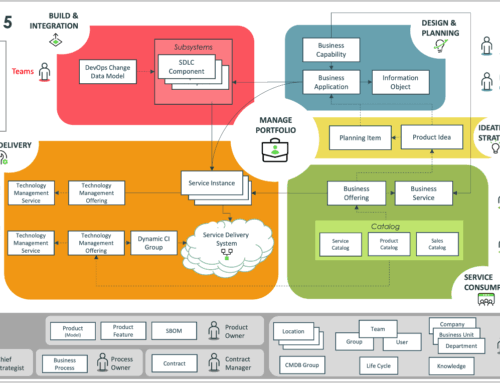Increasingly, IT is becoming an integral part of the business rather than merely supporting it. In some cases, IT has even changed businesses. Global online Platforms are rapidly taking over the end-user interaction from those companies that provide the sold products or services, thus drastically changing the way the providers conduct their business. Most enterprises have moved a significant portion of their homegrown solutions to the public cloud or replaced them with Software as a Service (SAAS) solutions. Emerging technologies such as artificial intelligence will likely rapidly change things further. Functionality is already being created on low-code or no-code platforms. AI will be integrated with these platforms in a matter of time. Due to more stringent compliance and privacy legislations, risks of cyber threats, etc., companies must also remain in control over (the transition to) these new technologies. The pace of change is still increasing, and keeping up with all the emerging changes is becoming hard. However, your business/customers will likely move to another company if you don’t keep up with changes. In conclusion, companies must be agile to survive in a rapidly changing world.
The way that IT is being managed is changing as well. Currently, developed solutions can automatically be integrated, tested, and deployed on an automatically provisioned infrastructure. Some companies release new functionality multiple times daily for all users/customers or only for a subset thereof. Companies that code themselves often use a mixture of different programming languages and operating systems (either by choice or autonomously). Hence, they often use over fifty tools to manage/automate IT. Many companies that “do IT themselves” have seen that integrating their IT tools has become more cumbersome than integrating their business IT solutions. This explains (to some extent) why some companies are now considering transitioning to low-code and no-code platforms and letting those platforms deal with the build, integration, deployment, and provisioning of IT functionality.
Computer users moved from a DOS command-line interface to a WINDOWS graphical interface in the previous century. Many people felt uncomfortable with this change because they lost insight and control of how things worked “under the hood.” Later on, some transitioned from a Windows to a Mac machine, in which it is uncommon to look “under the hood” when something is no longer working. A similar transition is expected when people move from coding/scripting to prompting/no-coding. Although no-code development will require specific skills, if/how the code/configuration will be created and deployed will disappear “under the hood” of the no-code platform.
Within the next decade, probably one or two dozen no-code platforms will remain that will deploy on commodity cloud infrastructure (of themselves or that of a third party). I consider it even more likely that SAAS solutions will be made available to provide an out-of-the-box functionality that can be used and customized using a no-code configuration aided by artificial intelligence. Newcomers will have the luxury of starting from scratch with a clean slate. If existing companies want to survive, they must rapidly replace their legacy solutions and transition to one (or a few) of the modern platforms. If the latter is feasible, is depend on how easy it will be to create new no-code solutions in five years. IT Management solutions will not disappear within the next decade. However, they will change in functionality and require new onboard technologies. IT Management is IT; thus, the same things that will happen IT will happen with IT Management. I.e., the use of AI will increase, and the IT Management solutions will soon support the management of (and integrate with) low-code/no-code solutions, incl. the infra it runs on. The interaction with users will be modernized. Most importantly: More will disappear “under the hood.”
The change will not come overnight; it will be a gradual change supported by new solutions that do not exist today but will only take months to emerge and be ready for use. In such a world, only a few companies can throw enough resources at it to keep up with the pace in the market. Most companies will be best off selecting a provider that provides an integrated suite of applications and innovates the suite, incl. supported practices. For the next decade, the IT Management suite needs to interact with popular legacy tools, e.g., to enable the reuse of existing investments, whilst the new world order is being built up and legacy tools will be replaced and/or become obsolete. The IT Management Practices will need to change in the coming years and be supported by an IT Platform. Rigorously adhering to traditional frameworks such as ITIL4 is most likely not a sustainable strategy. Adopting a higher level open standard supported/embraced by the IT4IT platform/suite provider will probably be a more successful route.
I’m impressed by version 3.0 of the IT4IT framework that the Open Group published in 2022. It provides a conceptual outline but allows IT4IT vendors to fill in the (ever-changing) details/gaps. It recognizes that companies are seeking a hybrid solution that will retain control over the planning of budgets/objectives whilst being agile to change during the year/quarter. It describes the scenarios, stages, and personas involved in the Practices. Best of all, it will allow companies to use different IT4IT-certified platforms and let them interact. E.g., one could choose to manage the Enterprise Architecture in one IT4IT platform and reuse its Portfolio data in another IT4IT platform. This increases the possibilities/capabilities of the IT4IT landscape but will also complicate the IT4IT landscape. Sometimes it will be better to use the on-board capabilities of one platform rather than integrating with another platform, especially if you intend to phase out the other platform within the next years.
IT4IT is probably an Enterprise’s most complex IT domain, especially if IT tools are procured together with (or as part of) specific IT Infrastructure. Each IT4IT tool’s intended purpose and intended audience must be clearly defined, and IT4IT Domain Architecture and IT4IT Roadmap must be carefully managed, as a whole. Which platform one shall choose for the next decade is hard to say since that choice depends on the current state, planned state, company size/maturity, and desired operating/transition model. E.g. a Small Enterprise that only uses a couple Out of Box SAAS/Cloud solutions will not likely need a heavy-weight IT4IT platform. An Enterprise that has outsourced its IT will have different needs than an Enterprise that loves to manage its homegrown IT itself. Most companies do not have a lot of integration skills in-house. They are probably better off using a platform offering out-of-the-box integrations and/or a suite that supports multiple practices on a single platform.
No matter which IT4IT-certified platform is chosen, for the next decade, it is probably wise to use the detailed practices that come with the platform and not customize them too much, thus allowing you to follow the vendor’s roadmap. Using Out-of-the-Box definitions, the glossary, and workflows will ensure you can follow the market pace and painlessly transition to new emerging market standards.







Geef een reactie